Performance Prediction of High-Speed Hydrogen Gas-Lubricated Herringbone Grooved Journal Bearing
Abstract
1. Introduction
2. Structure and Model
2.1. Herringbone Grooved Journal Bearing
2.2. Mathematical Model
2.3. Model Validation
2.4. Pressure Field of Hydrogen-Lubricated Herringbone Grooved Journal Bearings
3. Comparison of Gaseous Lubricant
3.1. Physical Property Difference
3.2. Performance of Different Gas-Lubricated Bearings
4. Influence Parameter Analysis
4.1. Ambient Pressure
4.2. Gas Film Clearance
4.3. Bearing Eccentricity Ratio
4.4. Discussion and Analysis
- The augmentation of ambient pressure increases the average pressure in the gas film, which is beneficial to bearing performance.
- The reduction in gas film clearance promotes the formation of a wedge-shaped clearance, which improves the bearing load capacity and critical mass.
- The increment in the bearing eccentricity ratio also intensifies the formation of a wedge-shaped clearance, enhancing bearing load capacity and working stability.
5. Conclusions
- (1)
- The physical properties of gas lubricants have a great influence on the bearing performance. The load capacity, friction torque, and critical mass of bearings of different gaseous lubricant decrease in the order of helium, air, nitrogen and hydrogen. In addition, the attitude angle of the bearings demonstrates a descending trend.
- (2)
- Increasing ambient pressure can increase the bearing capacity and critical mass. Meanwhile, the attitude angle decreases, and the friction torque is not obviously affected. Therefore, increasing the ambient pressure can be regarded as an effective method for improving the bearing load.
- (3)
- With decreasing gas film clearance and increasing bearing eccentricity ratio, the bearing load capacity, friction torque, and critical mass are enhanced, while the attitude angle decreases and operation stability is improved. Thus, lower gas film clearance and higher bearing eccentricity ratios can significantly boost the bearing performance.
Author Contributions
Funding
Institutional Review Board Statement
Informed Consent Statement
Data Availability Statement
Acknowledgments
Conflicts of Interest
References
- Filippov, S.P.; Yaroslavtsev, A.B. Hydrogen energy: Development prospects and materials. Russ. Chem. Rev. 2021, 90, 627. [Google Scholar] [CrossRef]
- Yamamoto, H.; Fujioka, H.; Okano, K. Cost analysis of stable electric and hydrogen energy supplies derived from 100% variable renewable resources systems. Renew. Energy 2021, 178, 1165–1173. [Google Scholar] [CrossRef]
- Shikhar, U.; Hemmes, K.; Woudstra, T. Exploring the Possibility of Using Molten Carbonate Fuel Cell for the Flexible Coproduction of Hydrogen and Power. Front. Energy Res. 2021, 9, 394. [Google Scholar] [CrossRef]
- Li, Y.; Kimura, S. Economic competitiveness and environmental implications of hydrogen energy and fuel cell electric vehicles in ASEAN countries: The current and future scenarios. Energy Policy 2021, 148, 111980. [Google Scholar] [CrossRef]
- Tarhan, C.; Çil, M.A. A study on hydrogen, the clean energy of the future: Hydrogen storage methods. J. Energy Storage 2021, 40, 102676. [Google Scholar] [CrossRef]
- Elberry, A.M.; Thakur, J.; Santasalo-Aarnio, A.; Larmi, M. Large-scale compressed hydrogen storage as part of renewable electricity storage systems. Int. J. Hydrogen Energy 2021, 46, 15671–15690. [Google Scholar] [CrossRef]
- Aziz, M. Liquid Hydrogen: A Review on Liquefaction, Storage, Transportation, and Safety. Energies 2021, 14, 5917. [Google Scholar] [CrossRef]
- Zhang, S.; Liu, G. Design and performance analysis of a hydrogen liquefaction process. Clean Technol. Environ. Policy 2022, 24, 51–65. [Google Scholar] [CrossRef]
- Chang, H.M.; Kim, B.H.; Choi, B. Hydrogen liquefaction process with Brayton refrigeration cycle to utilize the cold energy of LNG. Cryogenics 2020, 108, 103093. [Google Scholar] [CrossRef]
- Utlu, Z.; Karabuga, A. Conventional and enhanced exergy analysis of a hydrogen liquefaction system. Int. J. Hydrogen Energy 2020, 46, 2296–2305. [Google Scholar] [CrossRef]
- Lai, T.; Guo, Y.; Zhao, Q.; Wang, Y.; Zhang, X.; Hou, Y. Numerical and Experimental Studies on Stability of Cryogenic Turbo-Expander with Protuberant Foil Gas Bearings. Cryogenics 2018, 96, 62–74. [Google Scholar] [CrossRef]
- Faria, M.T.C. Some performance characteristics of high speed gas lubricated herringbone groove journal bearings. JSME Int. J. Ser. C Mech. Syst. Mach. Elem. Manuf. 2001, 44, 775–781. [Google Scholar] [CrossRef][Green Version]
- Gu, L.; Guenat, E.; Schiffmann, J. A Review of Grooved Dynamic Gas Bearings. Appl. Mech. Rev. 2020, 72, 010802. [Google Scholar] [CrossRef]
- Hou, Y.; Lai, T.; Chen, S.; Ma, B.; Liu, J. Numerical analysis on the static performance of tilting pad–journal gas bearing in subsystems. Tribol. Int. 2013, 61, 70–79. [Google Scholar] [CrossRef]
- Sim, K.; Lee, Y.B.; Song, J.W.; Kim, J.B.; Kim, T.H. Identification of the dynamic performance of a gas foil journal bearing operating at high temperatures. J. Mech. Sci. Technol. 2014, 28, 43–51. [Google Scholar] [CrossRef]
- Li, S.S.; Chen, H.H.; Ding, H.B.; Zhang, G.Y.; Dong, M.L. Dynamic Performances of the Herringbone-Grooved Gas Bearing. In Proceedings of the IOP Conference Series: Materials Science and Engineering 2018, Dalian, China, 1–3 July 2018; Volume 408. [Google Scholar] [CrossRef]
- Li, J.; Yang, S.Q.; Li, X.M.; Wu, J.H.; Li, Q. CFD research on hydrodynamic gas bearings with different styles of grooves. In Proceedings of the IOP Conference Series: Materials Science and Engineering 2017, Madison, WI, USA, 9–13 July 2017; Volume 278. [Google Scholar] [CrossRef]
- Li, Y.; Liu, J.; Li, L.; Yang, D. Effect of environmental pressure on dynamic characteristics of aerodynamic gas bearing of boost turbo expander. In Proceedings of the IOP Conference Series: Materials Science and Engineering 2018, Nanjing, China, 23–26 May 2018; Volume 382. [Google Scholar] [CrossRef]
- Zagarola, M.V.; Cragin, K.J.; McCormick, J.A. Operation of gas bearings at cryogenic temperatures. Cryogenics 2020, 105, 103001. [Google Scholar] [CrossRef]
- Davydov, A.B.; Sherstyuk, A.N. Features distinguishing hydrogen turboexpanders from air turboexpanders. Chem. Pet. Eng. 1996, 32, 453–456. [Google Scholar] [CrossRef]
- Davydenkov, I.A.; Davydov, A.B.; Perestoronin, G.A. Hydrogen and nitrogen turboexpanders with high gas expansion ratios. Cryogenics 1992, 32, 84–86. [Google Scholar] [CrossRef]
- Guo, Y.; Lai, T.; Ren, X.; Zhao, Q.; Hou, Y. Effect of lubrication medium on gas bearing performance. Lubr. Eng. 2021, 46, 1–5. [Google Scholar] [CrossRef]
- Yan, H.; Ke, C.; Peng, N.; Li, K.; Zhang, X.; Xiong, L.; Dong, B.; Li, J.; Liu, L. Performance prediction of externally pressurized gas bearings for high-speed turbo-expander involving hydrogen, helium and air working fluids. Int. J. Hydrogen Energy 2021, 46, 33453–33467. [Google Scholar] [CrossRef]
- Reynolds, O. On the theory of lubrication and its application to Mr. beauchamp tower’s experiments, including an experimental determination of the viscosity of olive oil. Phil. Trans. Roy. Soc. A 1885, 1, 157. [Google Scholar]
- Constantinescu, V.N. Basic Relationships in Turbulent Lubrication and Their Extension to Include Thermal Effects. J. Lubr. Technol. 1973, 95, 147–154. [Google Scholar] [CrossRef]
- Lund, J.W. Calculation of stiffness and damping properties of gas bearings. J. Lubr. Technol. 1968, 90, 793. [Google Scholar] [CrossRef]
- Klit, P.; Lund, J.W. Calculation of the dynamic coefficients of a journal bearing, using a variational approach. J. Tribol. 1986, 108, 421–425. [Google Scholar] [CrossRef]
- Ho, M.T.; Datta, A.; Bhattacharyya, S.P. An elementary derivation of the routh-hurwitz criterion. IEEE Trans. Autom. Control 1998, 43, 405–409. [Google Scholar]
- Bonneau, D.; Absi, J. Analysis of aerodynamic journal bearings with small number of herringbone grooves by finite element method. J. Tribol. 1994, 116, 698–704. [Google Scholar] [CrossRef]
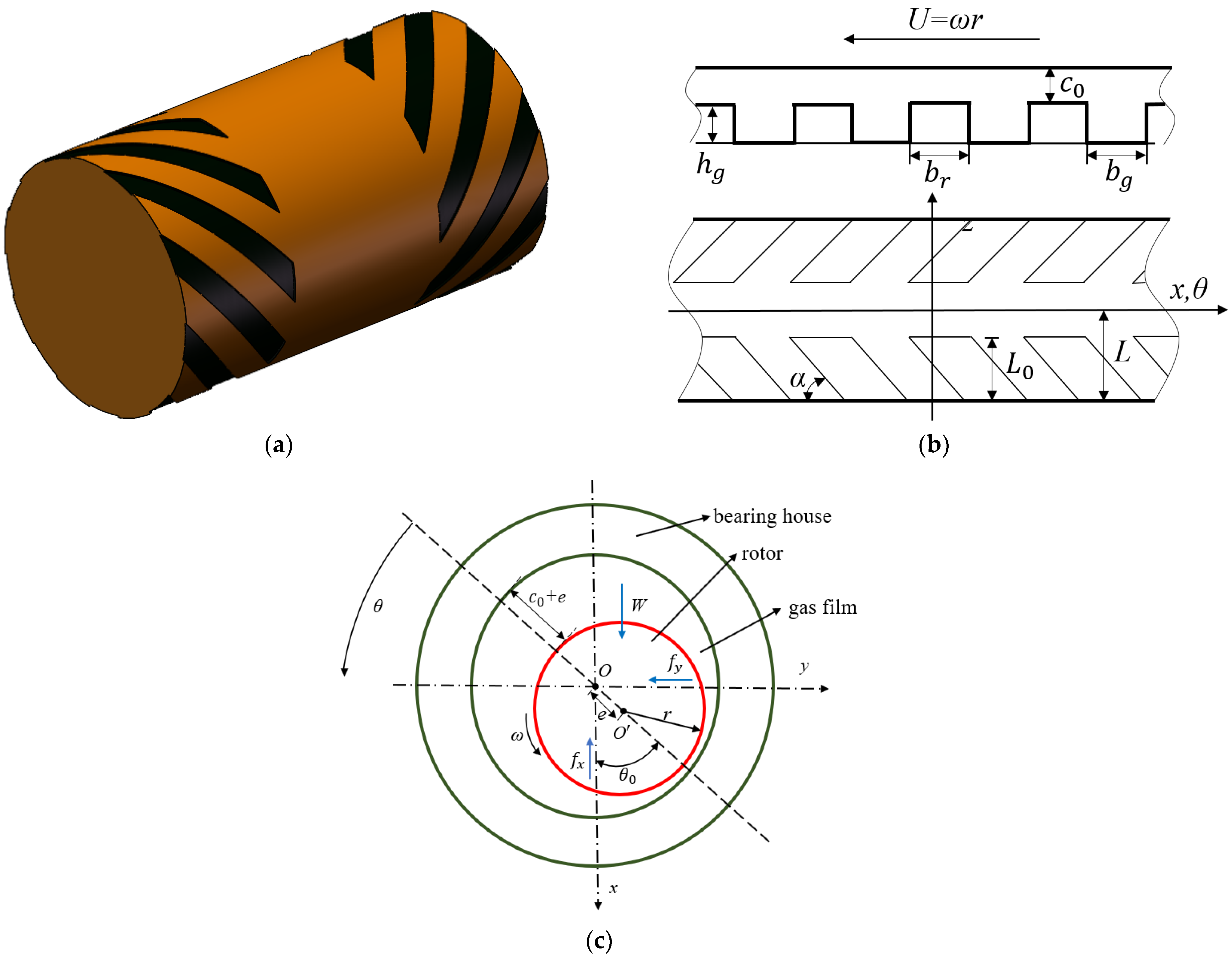

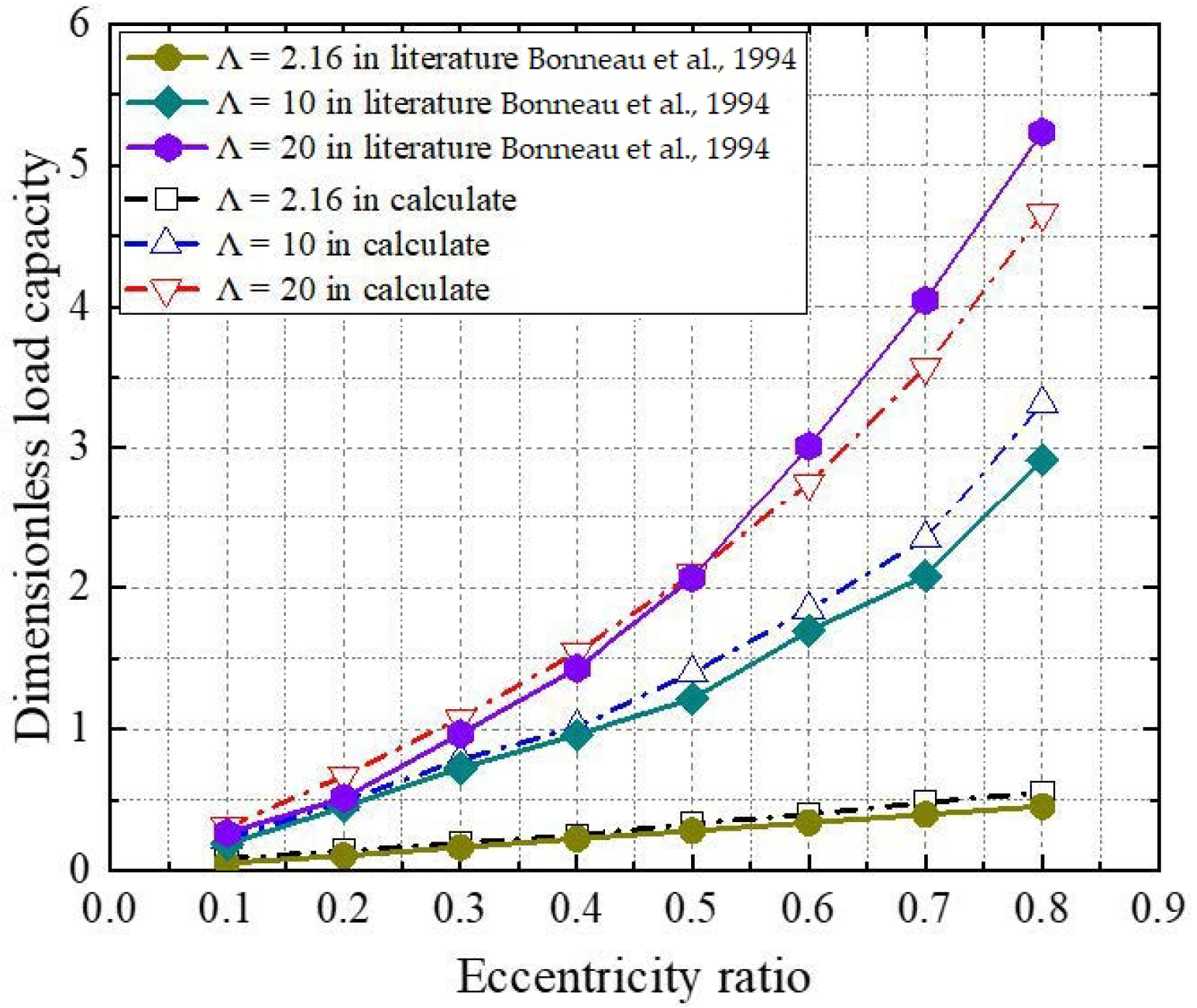



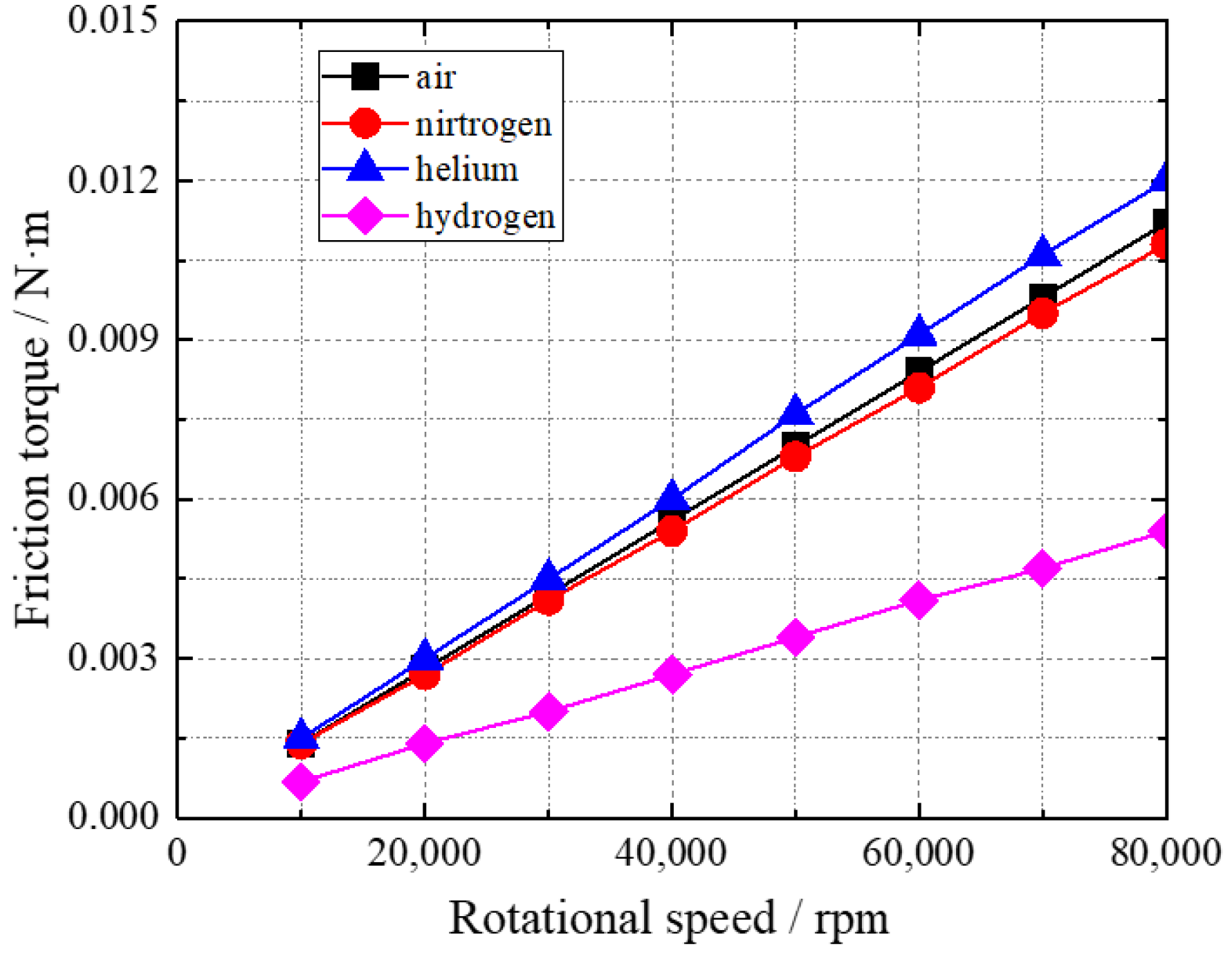
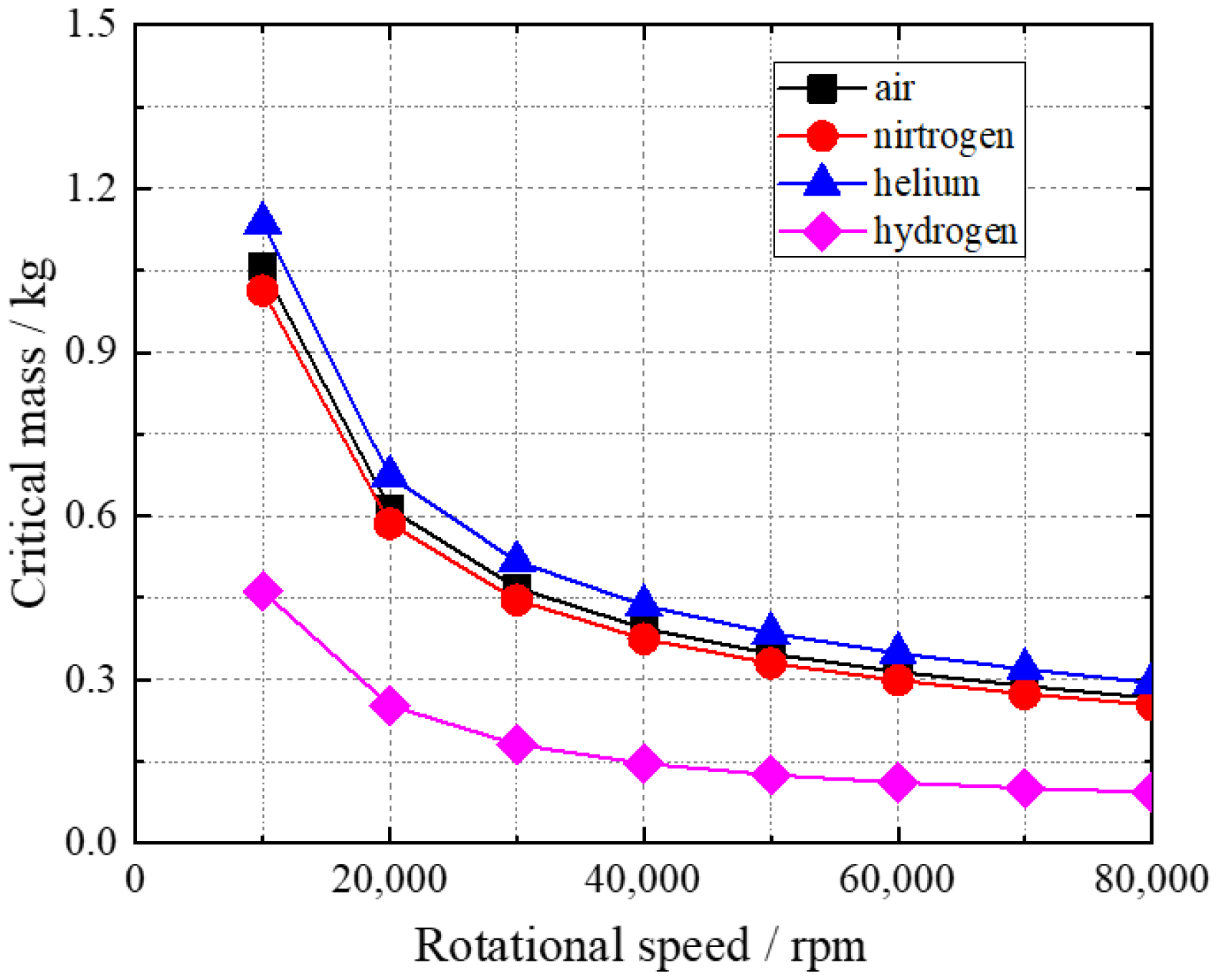
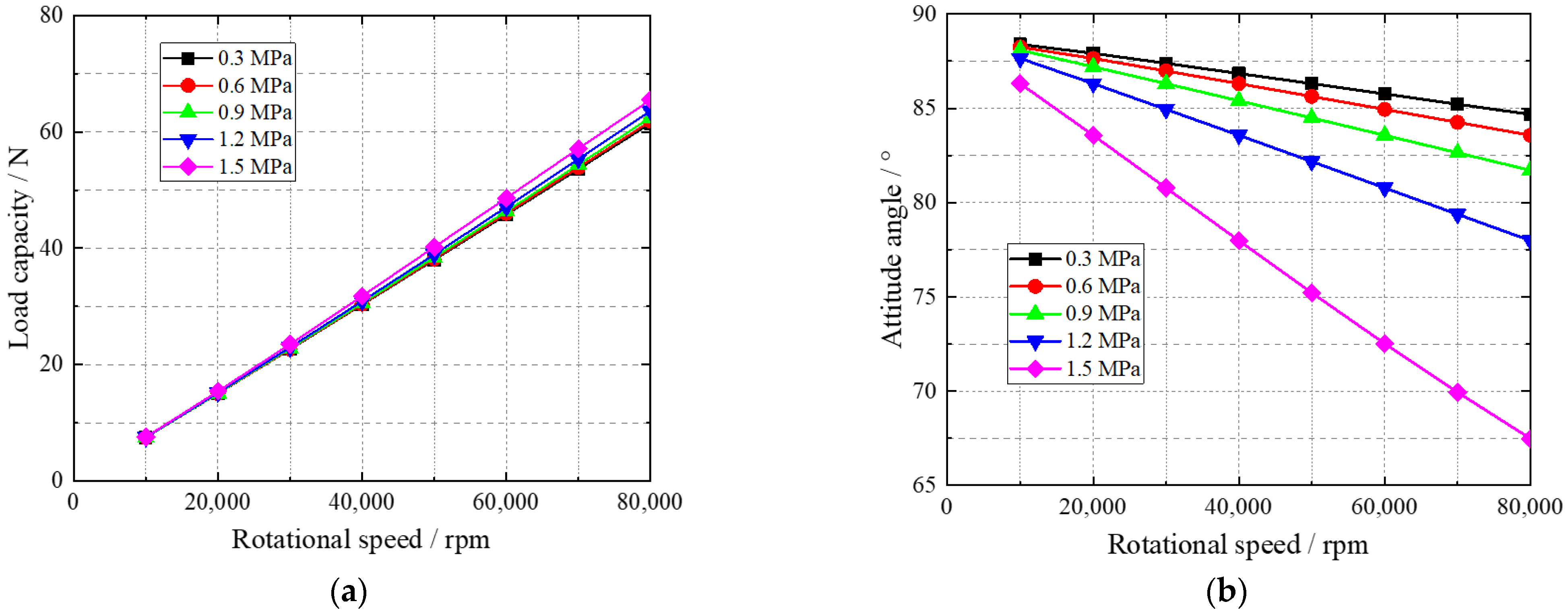
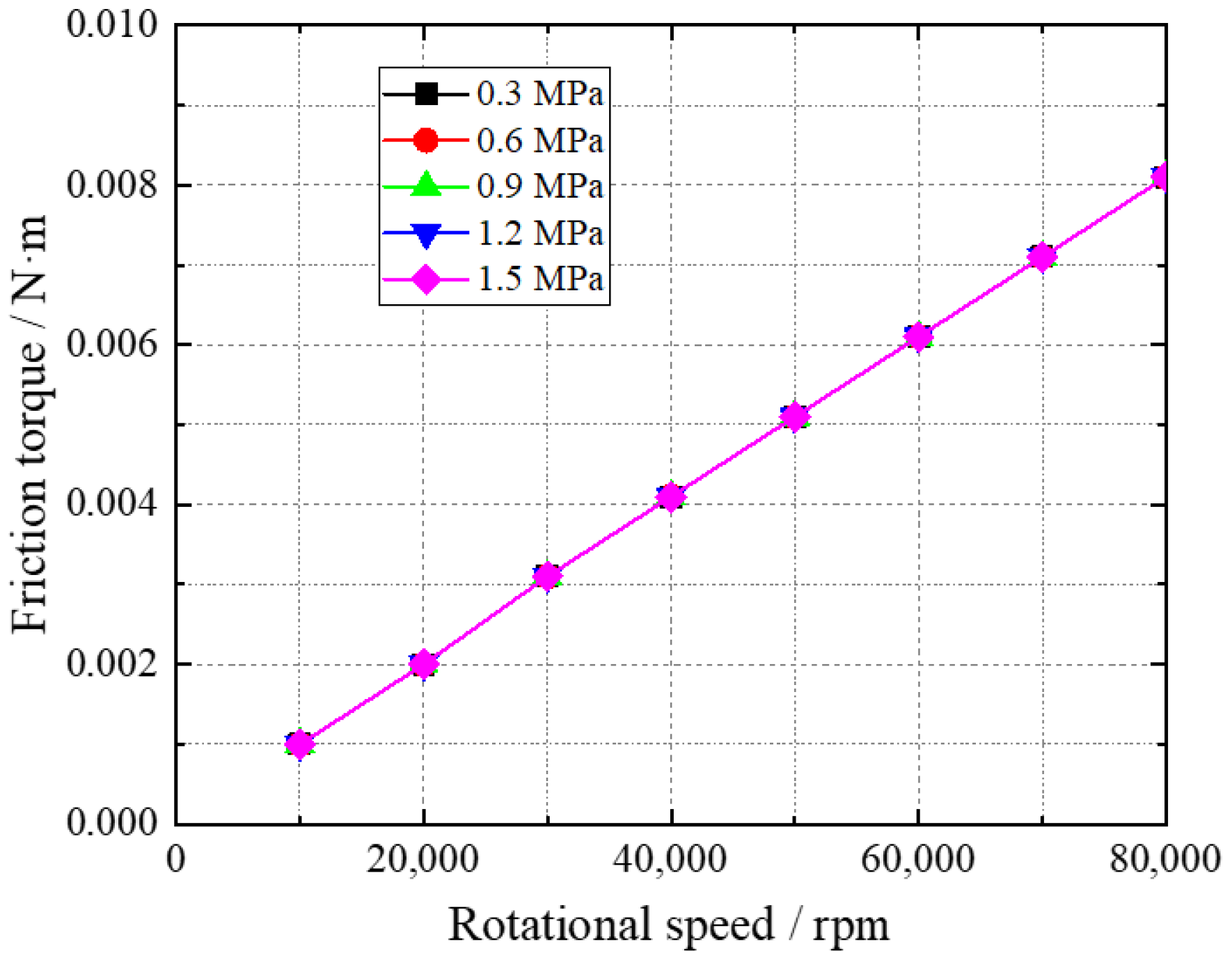

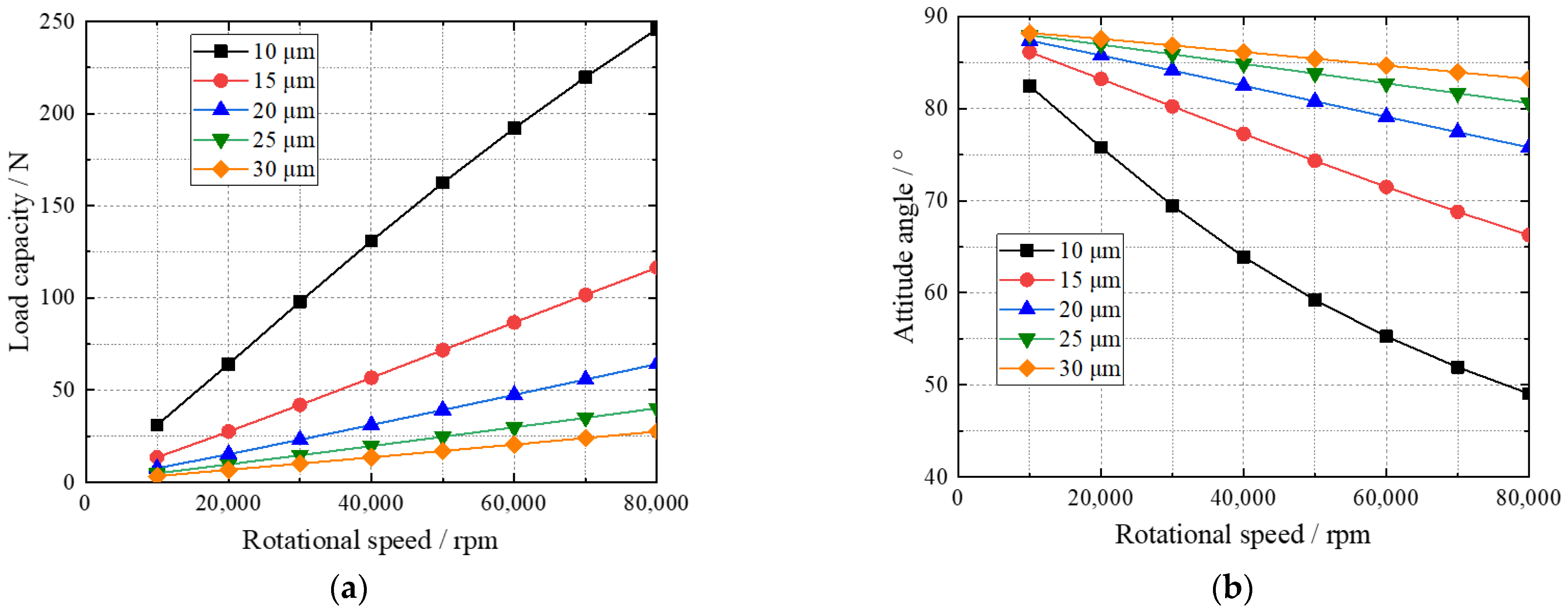
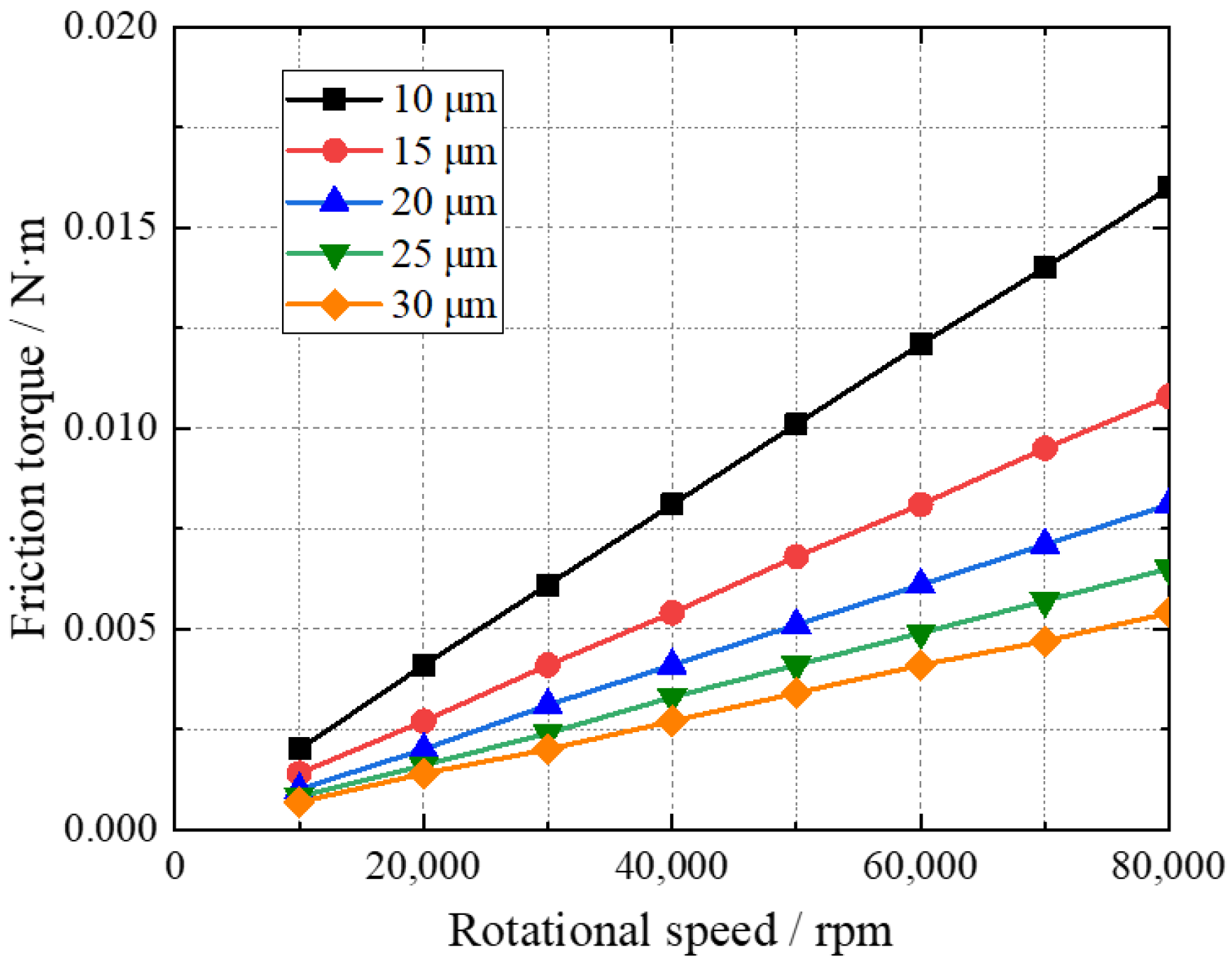
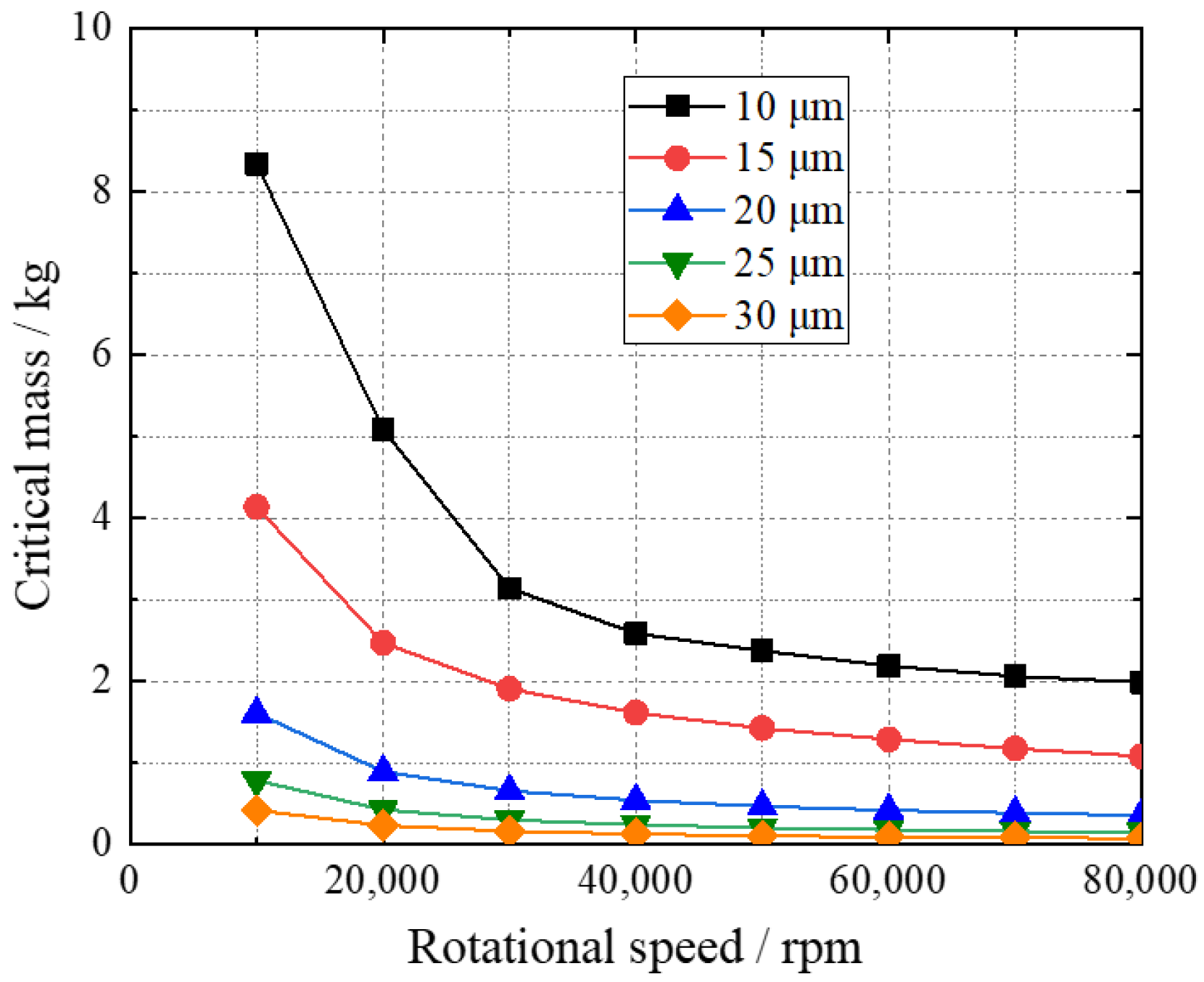
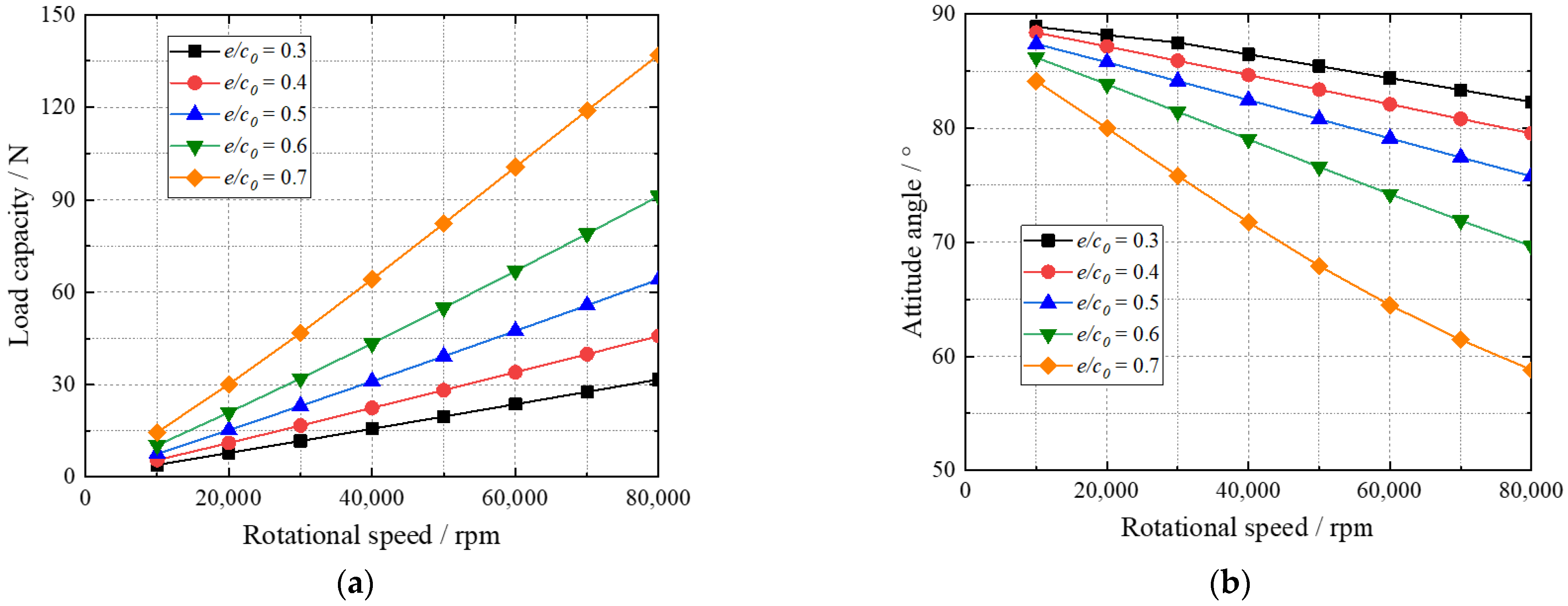
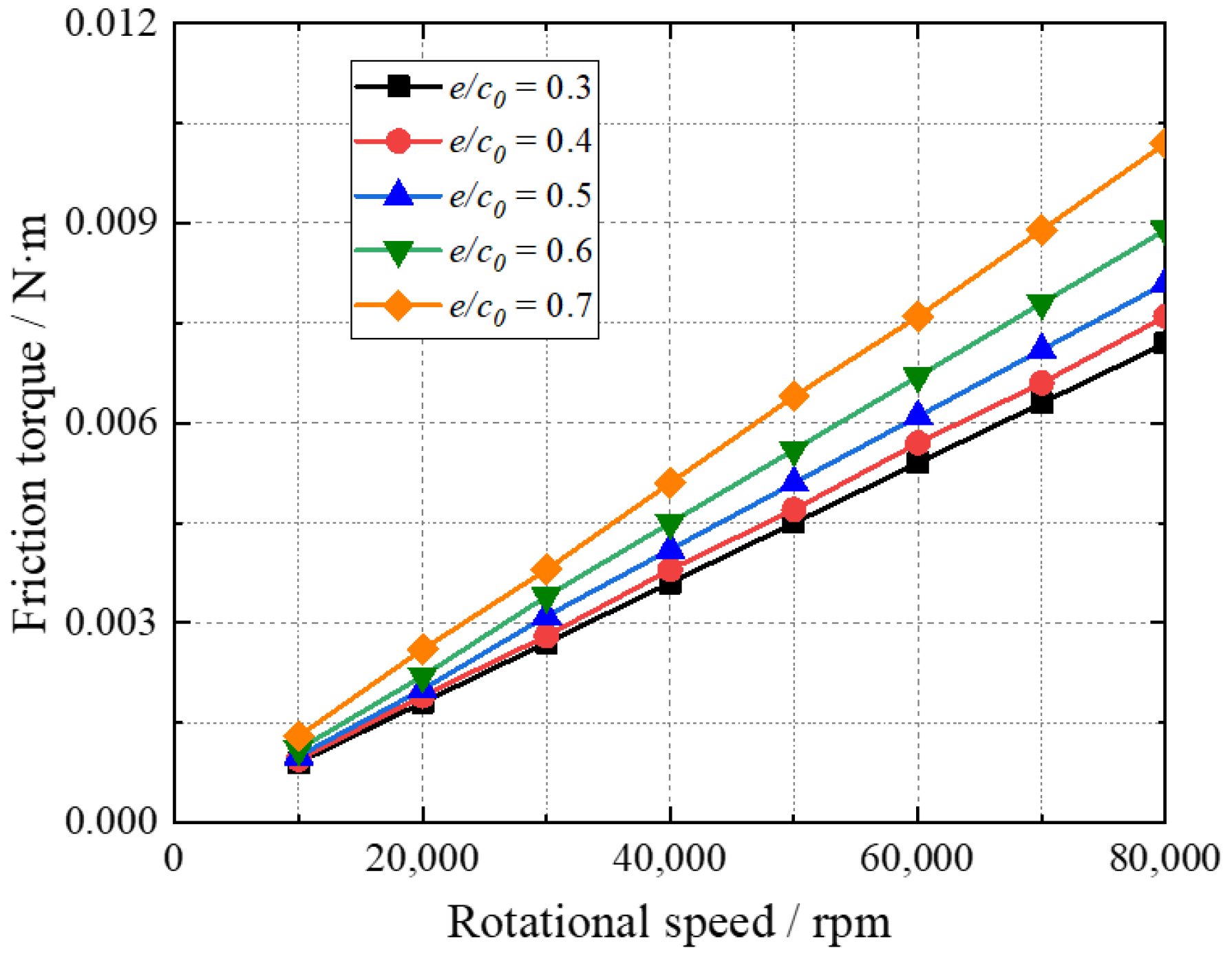

| Structural Parameters | Value | Unit |
|---|---|---|
| bearing length | 40 | mm |
| bearing radius | 20 | mm |
| film clearance | 20 | μm |
| groove depth | 20 | μm |
| groove angle | 60 | ° |
| number of grooves | 4 | / |
| groove circumferential ratio | 0.5 | / |
| groove axial ratio | 0.5 | / |
| eccentricity ratio | 0.5 | / |
Publisher’s Note: MDPI stays neutral with regard to jurisdictional claims in published maps and institutional affiliations. |
© 2022 by the authors. Licensee MDPI, Basel, Switzerland. This article is an open access article distributed under the terms and conditions of the Creative Commons Attribution (CC BY) license (https://creativecommons.org/licenses/by/4.0/).
Share and Cite
Qiang, M.; Zhao, Q.; Yan, S.; Liu, X.; Hou, Y.; Lai, T. Performance Prediction of High-Speed Hydrogen Gas-Lubricated Herringbone Grooved Journal Bearing. Appl. Sci. 2022, 12, 6432. https://doi.org/10.3390/app12136432
Qiang M, Zhao Q, Yan S, Liu X, Hou Y, Lai T. Performance Prediction of High-Speed Hydrogen Gas-Lubricated Herringbone Grooved Journal Bearing. Applied Sciences. 2022; 12(13):6432. https://doi.org/10.3390/app12136432
Chicago/Turabian StyleQiang, Mingchen, Qi Zhao, Shaohang Yan, Xue Liu, Yu Hou, and Tianwei Lai. 2022. "Performance Prediction of High-Speed Hydrogen Gas-Lubricated Herringbone Grooved Journal Bearing" Applied Sciences 12, no. 13: 6432. https://doi.org/10.3390/app12136432
APA StyleQiang, M., Zhao, Q., Yan, S., Liu, X., Hou, Y., & Lai, T. (2022). Performance Prediction of High-Speed Hydrogen Gas-Lubricated Herringbone Grooved Journal Bearing. Applied Sciences, 12(13), 6432. https://doi.org/10.3390/app12136432








